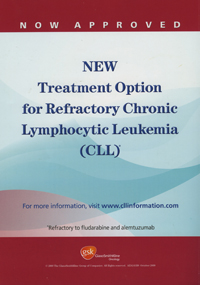The FDA scolded GlaxoSmithKline over a disease-awareness ad that failed to mention side effects but alluded to newly approved cancer treatment Arzerra.
The violation, communicated by the FDA through an untitled letter, raised eyebrows in legal circles, since disease-awareness communications typically are not subject to side-effect disclosure requirements. “The implications of that letter here are that [FDA is] going to construe the disease-awareness exception very narrowly,” said Arnold Friede, a former top Pfizer lawyer and expert on FDA law. “It also reflects their desire to stake out a broad scope for their authority.”
The case highlights a controversial aspect of FDA’s 2004 draft guidance covering disease-awareness ads—communications aimed at consumers or healthcare practitioners “that discuss a particular disease or health condition, but do not mention any specific drug or device or make any representation or suggestion concerning a particular drug or device.”
According to FDA’s draft guidance, which reflects current FDA policy, product-specific communications must include, among other things, “information in brief summary relating to side effects, contraindications, and effectiveness.” Disease-awareness communications are not subject to the requirements of the Federal Food, Drug, and Cosmetic Act with respect to disclosure of side effects.
However, there are circumstances in which FDA will treat a supposed disease-awareness piece as conventional branded advertising. One is if FDA determines that a supposed disease-awareness ad “impliedly identifies a particular drug or device.” This may be the case when a communication relates to a drug that is the only product in its diagnostic or therapeutic class.
The ad for Arzerra (ofatumumab) targeted healthcare professionals, running in the December 1, 2009, issue of Journal of Clinical Oncology. Without identifying Arzerra explicitly, the ad mentions the availability of a new drug for adult chronic lymphocytic leukemia (CLL) that is resistant to fludarabine and alemtuzumab and features the GSK logo at the bottom.
As to why the ad was considered promotional, the FDA’s Division of Drug Marketing, Advertising, and Communications (DDMAC) stated in the letter, “The characteristics of the product promoted in the ad can only describe Arzerra. Not only is Arzerra the only recently approved drug marketed by GSK for CLL, but no other product approved for the treatment of CLL has an indication that is limited to this specific population.” Arzerra was approved in October and launched in mid-November.
“Consequently,” DDMAC added, “this presentation is a product-specific prescription drug ad for Arzerra” and is subject to disclosure of warnings and precautions related to infusion reactions, among others, as well as common adverse reactions, including pneumonia, cough and diarrhea, among many others. GSK was also cited for not submitting the ad for DDMAC review prior to being published.
“We are addressing the issue and will be responding to the FDA in a timely manner,” GSK spokesman Ken Inchausti told MM&M. He added that the awareness ad was transitioned out following the drug’s launch.
Friede said the 2004 disease-awareness draft guidance are somewhat contentious because they give FDA a basis for “summarily concluding that an otherwise unidentified product is unmistakably communicated by the collection of information in the ad” and are thus subject to the risk-disclosure requirement.
“At the time the draft guidance was published,” he said, “there was a lot of concern among one-product companies,” specifically whether these companies would ever do disease-awareness for orphan-type conditions, “where everybody knows whose product you’re talking about.”
Taken together with other recent FDA notices of violation, the Arzerra letter is also suggestive of a move to broaden jurisdiction on promotions. In January the FDA cited a clinical investigator for the product Dysport, a botulinum toxin product similar to Botox which was ultimately approved, claiming promotional violations for participating in magazine interviews prior to approval. The investigator’s interview statements, which appeared in Allure and Elle and on the Today Show, were subject to rules on pre-approval communication, even though the investigator was acting on her own behalf, not on that of Medicis, the company responsible for marketing Dysport for glabellar lines, the agency’s Jan. 11 letter stated.
Friede said the Arzerra letter is consistent with the Dysport letter, although the subject matter is completely different. The FDA is “going to find things that are within [its] jurisdiction when given the opportunity to do so,” he said.
The GSK letter is also a teachable moment for medical communications agencies, said Friede, who has been trying to convince agencies that there is a “value-add” to coming into client meetings prepared to make the case as to why their copy is compliant.
“They [agencies] don’t want to bring copy that’s not really reflective of what the current enforcement climate is,” he said. If they do, “[the creatives] have to go back and rewrite copy, and there is an enormous amount of frustration on both sides.” He added, “Agencies ought to be really on top of this.”







